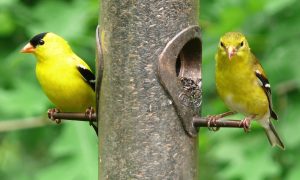
If you are like me, you may need a short break from the daily onslaught and anguish of thinking about how our country is choosing to deal with the critical environmental problems of today…… so, for the moment, let’s ask whether bird feeding is good for birds.
My wife and I just returned from the Asa Wright Nature Center in Trinidad, where our guides told us that they feed an astounding 8 gallons of sugar water each day to the local population of 12 species of hummingbirds. Suddenly, it did not seem so outrageous to think that we feed several hundred pounds of seed each year to our backyard birds. No doubt the birds appreciate the free handouts, and we like to see the birds from our living room window.
One study in Illinois found that with supplemental food from birdfeeders, birds were fatter, grew new feathers faster, and had lower levels of stress hormones in their blood. These attributes disappeared when the bird feeding stopped. Birdfeeders in Wisconsin nearly doubled the winter survival of chickadees. Many species can survive cold winter nights only by shivering, which uses a lot of metabolic energy to generate body heat.
Other studies have cast a pall over bird feeding, indicating that birdfeeders are a locus for the transmission of disease, for collisions of birds with windows, and for exposure of high numbers of birds to obvious predators. I can certainly attest to the latter, having seen Sharp-shinned Hawks and housecats stalking birds under birdfeeders at our house. For diseases, at least one study has found the occurrence of avian conjunctivitis was lower and the numbers of House Finch were higher in areas with fewer birdfeeders.
Feeding the birds is also blamed for changes in the local biodiversity of birds, especially in suburbs. By aiding in winter survival, birdfeeders are implicated in the spread of southern birds, such as the Northern Cardinal, to northern habitats during the past few decades. Now, we all like to see a brilliant red cardinal against the snow, but cardinals in Maine are really a new addition to the bird fauna that is native in that region.
Some bird species are found at higher numbers around birdfeeders, whereas others do not respond. Unfortunately, too often, the abundant species are exotics, such as finches and starlings, which are not part of the natural fauna of the region in question. If we are serious about preserving the natural heritage of biodiversity, bird feeding may not be the best activity.
My review of the available science suggests that the jury is still out on bird feeding. The question is fraught with conflicting science. But, I cannot help but think that, like humans, birds are happier when they are well fed.
In a kinder and gentler world, that might be a solution to an environmental problem we could all agree upon.
References
Brittingham, M.C. and S.A. Temple. 1988. Impacts of supplemental feeding on survival rates of Black-capped Chickadees. Ecology 69: 581-589.
Fischer, J.D. and J.R. Miller. 2015. Direct and indirect effects of anthropogenic bird food on population dynamics of a songbird. Acta Oecologica 69: 46-51.
Galbraith, J.A., J.R. Beggs, D.N. Jones, and M.C. Stanley. 2015. Supplemental feeding restructures urban bird communities. Proceeding of the National Academy of Sciences 112: 2648-2657.
Robb, G.N., R.A. McDonald, D.E. Chamberlain, and S. Bearhop. 2008. Food for thought: Supplementary feeding as a driver of ecological change in avian populations. Frontiers in Ecology and Environment 6: 476-484.
Wilcoxen, T.E. and 9 others. 2015. Effects of bird-feeing activities on the health of wild birds. Conservation Physiology 3: doi: 10.1093/conphys/conv058
